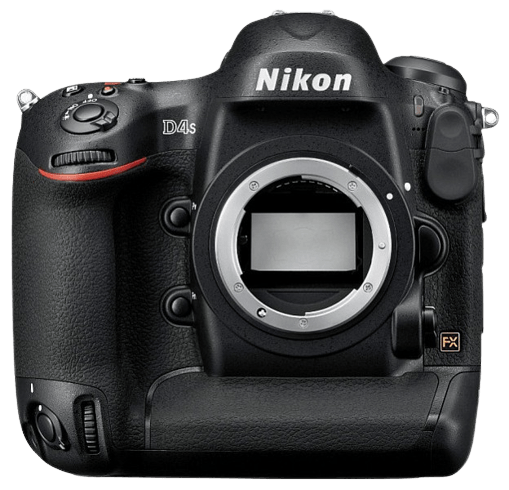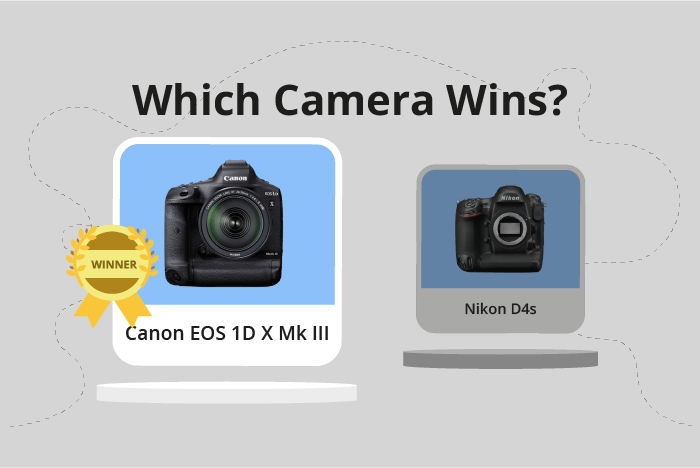Canon EOS 1D X Mark III vs Nikon D4s Comparison
Canon EOS 1D X Mark III

Nikon D4s

The Canon EOS 1D X Mark III outperforms the Nikon D4s with a score of 75/100 compared to 62/100. Both cameras are DSLR types, launched at the same price of $6500. They share some similarities in their specifications, such as camera type and launch price.
The Canon EOS 1D X Mark III has the advantage in terms of size and weight, being smaller and lighter at 158 x 168 x 83mm and 738g (1.63lbs) compared to the Nikon D4s at 160 x 157 x 91mm and 1350g (2.98lbs). This makes the Canon model more portable and easier to handle during photography sessions.
The Nikon D4s, being released in 2014, is an older model compared to the Canon EOS 1D X Mark III, which was released in 2020. This age difference may contribute to the lower score of the Nikon D4s. However, the Nikon D4s still maintains its value as a reliable DSLR camera at the same launch price as the Canon model.
Considering the specifications and scores, the Canon EOS 1D X Mark III is the superior choice due to its more recent release and lighter, more compact design. The Nikon D4s remains a valid option for those who prioritize other factors or have brand loyalty.
Canon EOS 1D X Mark III vs Nikon D4s Overview and Optics
The Canon EOS 1D X Mark III emerges as the winner in the optics comparison, with a score of 74/100, while the Nikon D4s scores 62/100. Both cameras share some common specifications, such as having a CMOS sensor, full frame sensor size, and no image stabilisation. Additionally, they both use their respective brand’s lens mounts – Canon EF for the 1D X Mark III and Nikon F FX for the D4s.
The Canon EOS 1D X Mark III excels in several aspects. It boasts a higher megapixel count of 20.1, compared to the Nikon D4s’ 16.2 megapixels, allowing for greater detail and image quality. The 1D X Mark III also has a faster shooting speed of 20 frames per second, compared to the D4s’ 11 frames per second, which enables capturing fast-moving subjects more effectively. Furthermore, the 1D X Mark III’s sensor has a higher DXOMARK score of 91, while the D4s’ sensor scores 89, indicating better overall performance.
On the other hand, the Nikon D4s has a few advantages. Its Expeed 4 processor, although not as advanced as the Canon’s Digic X, still delivers reliable performance and image processing capabilities. However, these advantages do not outweigh the benefits offered by the Canon EOS 1D X Mark III.
The Canon EOS 1D X Mark III stands out as the better camera in terms of optics, with its higher megapixel count, faster shooting speed, and superior sensor performance. The Nikon D4s, while not a poor performer, falls short in comparison. This analysis highlights the strengths of the Canon EOS 1D X Mark III, making it the preferred choice for photographers seeking exceptional optical performance.
Canon EOS 1D X Mark III vs Nikon D4s Video Performance
The Canon EOS 1D X Mark III outperforms the Nikon D4s in video capabilities, scoring 91 out of 100 compared to the Nikon D4s’s score of 70. Both cameras share some common specifications, such as having built-in time-lapse functionality, which allows for creating stunning time-lapse videos without the need for additional equipment.
The Canon EOS 1D X Mark III excels with a higher maximum video resolution of 4K (4096 x 2160), while the Nikon D4s only supports Full HD (1920 x 1080). This difference in resolution means that the Canon EOS 1D X Mark III can capture more detailed and sharper videos, providing a significant advantage for filmmakers and videographers who require high-quality footage. Furthermore, the Canon EOS 1D X Mark III has a higher maximum video frame rate of 120fps, twice that of the Nikon D4s’s 60fps. This higher frame rate allows for smoother slow-motion effects, offering more creative possibilities for video projects.
Despite the lower score, the Nikon D4s still performs well in video capabilities, especially for photographers who do not require 4K resolution or higher frame rates. The Full HD resolution and 60fps frame rate are sufficient for most casual video shooting and can still produce high-quality footage.
In comparing the video capabilities of the Canon EOS 1D X Mark III and the Nikon D4s, the Canon model is the clear winner due to its superior resolution and higher frame rate. However, the Nikon D4s remains a viable option for those who do not require the highest video quality and prefer to prioritize other camera features.
Canon EOS 1D X Mark III vs Nikon D4s Features and Benefits
The Canon EOS 1D X Mark III outperforms the Nikon D4s with a feature score of 74/100 compared to 57/100. Both cameras share some common specifications, such as a 3.2-inch screen size, no flip screen, WIFI connectivity, and no Bluetooth.
The Canon EOS 1D X Mark III surpasses the Nikon D4s in several aspects. Firstly, it has a higher screen resolution of 2,100,000 dots, providing better image quality on the display. Secondly, it features a touchscreen, which enhances user experience and facilitates menu navigation. Finally, the Canon EOS 1D X Mark III has GPS, allowing users to geotag their images and track shooting locations.
On the other hand, the Nikon D4s does not offer any significant advantages over the Canon EOS 1D X Mark III in terms of features. It has a lower screen resolution of 921,000 dots and lacks both a touchscreen and GPS.
Considering these points, the Canon EOS 1D X Mark III emerges as the superior camera in terms of features. Its higher screen resolution, touchscreen, and GPS functionality make it a more versatile and user-friendly option for photographers. In contrast, the Nikon D4s does not provide any notable advantages, making it a less appealing choice in this comparison.
Canon EOS 1D X Mark III vs Nikon D4s Storage and Battery
The Canon EOS 1D X Mark III and Nikon D4s both score 87/100 in storage and battery. They share similarities in having two memory card slots and lacking USB charging capabilities. However, there are differences in memory cards accepted and battery life.
The Canon EOS 1D X Mark III accepts CFexpress Type B memory cards. Its battery life is 2850 shots, powered by an LP-E19 battery. In contrast, the Nikon D4s accepts Compact Flash and XQD memory cards. It offers a longer battery life of 3020 shots, using an EN-EL18a battery.
Although the Canon EOS 1D X Mark III has a more advanced memory card format, the Nikon D4s has an advantage in battery life and memory card versatility. Both cameras excel in storage and battery performance, making them strong contenders in the professional photography market.
Canon EOS 1D X Mark III vs Nikon D4s – Our Verdict
Are you still undecided about which camera is right for you? Have a look at these popular comparisons that feature the Canon EOS 1D X Mark III or the Nikon D4s:

